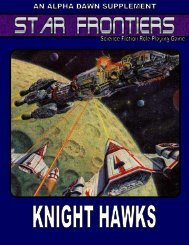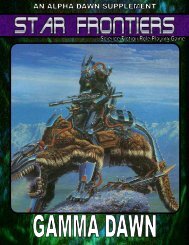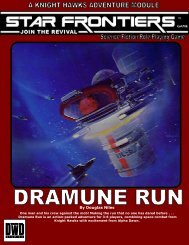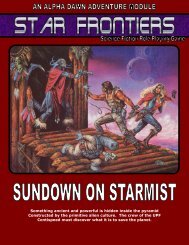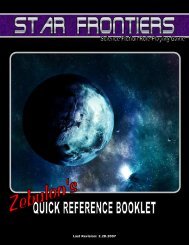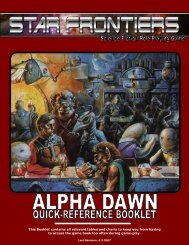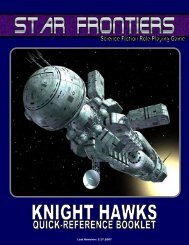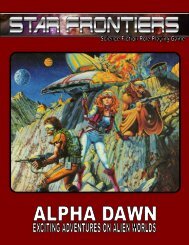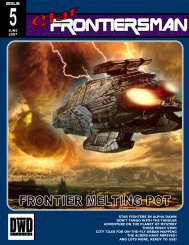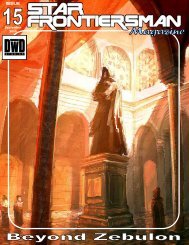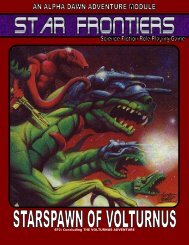Alpha Dawn - Star Frontiersman
Alpha Dawn - Star Frontiersman
Alpha Dawn - Star Frontiersman
You also want an ePaper? Increase the reach of your titles
YUMPU automatically turns print PDFs into web optimized ePapers that Google loves.
mining natural resources. The planet also has some<br />
industry, but not enough to process all the materials<br />
that are mined.<br />
Colonizers<br />
This indicates which of the four races settled the<br />
planet. This race will be the most common on the<br />
planet, and will control the government.<br />
Abbreviations are used to indicate which race<br />
colonized the planet:<br />
78<br />
Code Colonizers<br />
D Dralasites<br />
H Humans<br />
V Vrusk<br />
Y Yazirians<br />
* a mixture of several races<br />
Gravity<br />
This is simply the strength of gravity on the planet.<br />
It is measured in multiples of 1 9, which is<br />
considered normal gravity. The effects of gravity are<br />
described in the section on Movement.<br />
Moons<br />
This indicate the number of moons orbiting the<br />
planet. Many planets have small moons that have<br />
never been fully explored. Some large planets have<br />
moons that are big enough to have atmospheres.<br />
Moons can also have rings.<br />
Length of Day<br />
This is the number of hours the planet takes to<br />
complete one rotation, or the number of hours from<br />
sunrise to sunrise.<br />
<strong>Star</strong> Color<br />
The color of the star that the planet orbits also is<br />
listed. This has no effect on the game, but the<br />
referee can use it to add to his descriptions.<br />
Notes<br />
Some planets have additional notes following the<br />
table. These describe unusual cultures or planetary<br />
features. The referee can make up any other<br />
information he needs about the planets when he<br />
designs adventures to place on them.<br />
SPACE TRAVEL<br />
<strong>Star</strong>ships can travel between star systems at speeds<br />
many times faster than the speed of light. A trip<br />
that would have taken hundreds of years in a<br />
spaceship could be made in only a few days in a<br />
faster-than-light (FTL) starship. Because of their<br />
cost, however, most starships in the Frontier are<br />
owned by large corporations, planetary governments<br />
or starship travel companies.<br />
The established travel routes are marked on the<br />
Frontier map. These are the only explored routes<br />
that have been mapped and certified as safe for<br />
starships to use. When adventurers travel, they are<br />
limited to scheduled or chartered trips following<br />
these routes.<br />
Travel Time<br />
The length of each route in light-years is printed on<br />
each route. Because FTL ships travel one light-year<br />
per day, this number also is the number of days<br />
needed to travel this route. This time includes takeoff<br />
and landing, maneuvering in orbit, passenger<br />
loading and all other normal procedures. For<br />
example, the route from Prenglar to Cassidine is 7<br />
light-years. A starship traveling from Prenglar to<br />
Cassidine, or from Cassidine to Prenglar, would take<br />
7 days (140 hours) to reach its destination.<br />
Most starships never land on a planet. Passengers<br />
board shuttles on the ground that take them into<br />
orbit, where they board the starship. When the<br />
starship reaches its destination, shuttles again take<br />
the passengers either to the planet's surface or to<br />
an orbiting space station where they can wait for<br />
another flight.<br />
<strong>Star</strong>ship Tickets and Costs<br />
Travelers can buy three types of starship tickets:<br />
First Class, Journey Class and Storage.<br />
First Class. First Class tickets are the most<br />
expensive, but First Class passengers get the best<br />
food, the biggest cabins and on-board<br />
entertainment. A First Class passenger can bring<br />
along up to 1 metric ton of cargo at no extra charge.<br />
The First Class section also is closest to the<br />
starship's lifeboats and emergency spacesuits, so<br />
First Class passengers have the best chance to<br />
survive a catastrophe. A First Class ticket costs 200<br />
Credits per light-year traveled. For example, a First<br />
Class ticket from Prenglar to Cassidine costs 1,400<br />
Credits.<br />
Journey Class. Travelers with Journey Class tickets<br />
get smaller cabins, poorer-quality food and no<br />
entertainment. A journey Class passenger can bring<br />
along up to .5 metric ton of cargo at no extra<br />
charge. In addition, they are farther from the<br />
lifeboats than First Class passengers. A Journey<br />
Class ticket costs 100 Credits per light-year<br />
traveled.<br />
Storage. Passengers traveling Storage Class ship<br />
themselves as cargo. The passenger is frozen and<br />
stored in a special berth. The frozen passengers are<br />
revived at their destination. A Storage Class ticket<br />
costs 30 Credits per light-year traveled, and<br />
includes up to 100 kg of cargo.



